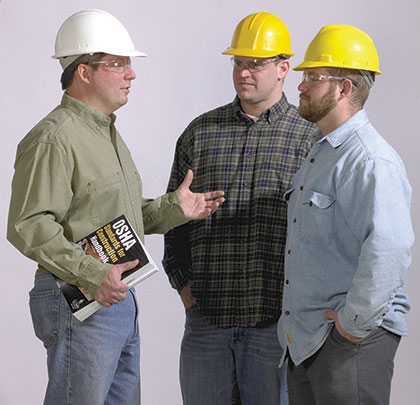Contract workers are a common sight at many facilities. These workers often perform very specialized and potentially hazardous tasks, such as confined space entry work and non-routine repair and maintenance activities. Because of this, these contract employees, and the work they do, must be coordinated and controlled.
In addition, under the OSHA multi-employer worksite policy, citations may be issued to employers using contract employees. OSHA’s multi-employer worksite citation policy states that on multi-employer worksites, more than one employer may be citable for a hazardous condition that violates an OSHA standard.
This is why you, as the host employer, need to take extraordinary care to ensure these workers will be safely performing the jobs you hired them to do.
CONTRACTOR RESPONSIBILITIES TO THE HOST EMPLOYER
When hiring a contractor, you should expect to get specific information from them before work begins. Require the contractor to:
- Name a representative to coordinate all safety and health issues and communicate with you.
- Provide documentation of any necessary safety training, such as forklift or lockout/tagout training.
- Sign a confidentiality statement to protect your company’s proprietary data.
Provide information on the safety and health hazards that may arise during the course of the contractor’s work at this company, and the means necessary to avoid danger from those hazards. - Read and understand your facilities’ safety rules.
- Be informed of emergency signals and procedures where its employees are working.
Have the telephone numbers of the nearest hospital, ambulance service, and fire department. - Know who to call and what to do in emergencies, including where first-aid and medical services are located, and how to train employees.
- Advise and train its employees on hazards associated with the work to be performed, including any Hazard Communication or other hazard information provided to the contractor by you, or your designated representative.
- Keep you or your representative fully informed of any work that may affect your employees or property.
CONTRACTOR RESPONSIBILITIES TO THEIR EMPLOYEES
There are certain safety procedures that the contractors need to address with their employees before they go on a worksite. Some of these include:
- Assuring that employees are trained in the work practices necessary to perform the job safely, including potential fire, explosion, or toxic release hazards.
- Assuring that employees know the applicable provisions of the emergency action plan.
- Documenting contract employee training.
- Requiring that all subcontractors abide by the same rules.
- Complying with the host facility’s smoking policy.
- Providing a current workers’ compensation insurance certificate and general liability coverage with the contracting company.
- Ensuring that employees comply with all applicable local, state, and federal safety requirements, as well as with any safety rules and regulations set forth by the company at which it is performing the contracted work.
- Communicating multi-employer roles and responsibilities regarding safety requirements.
WHEN THE CONTRACTOR ARRIVES
When they arrive on site, it’s important the contractor:
- Has a designated site safety coordinator present and attentive to the work being carried out at all times by the contractors and/or subcontractors that are working at the facility site.
- Establishes necessary safe practices to permit work under operating conditions without endangering the company’s associates and property; this includes, but is not limited to, barricading, sign posting, and fire watches.
- Makes sure that any equipment, chemicals, or procedures used by the contractor to perform contracted work meets all OSHA requirements.
- Is responsible and accountable for any losses or damages suffered by this company and/or its employees as a result of contractor negligence.
- Provides its employees with medical care and first-aid treatment; plant first-aid facilities may be used only in case of emergencies.
- Uses only the plant or building entrance designated and follows the facility access control practice; the contractor also will ensure that each contractor employee is issued and wears some form of easily seen identification.
- Provides supervisors and employees who are competent and adequately trained, including training in all health and safety aspects of the work involved in the contract; provide all tools and equipment for the work, including personal protective equipment (PPE), and ensure the equipment is in proper working order, and that employees are instructed in its proper use.
- Notifies you or your designated representative immediately of any OSHA recordable injury or illness to contractor employees or subcontractor employees occurring on your site.
- Provides a copy of each accident report to the designated representative.
Receives and uses a copy of the facility’s written safety policies and procedures.
Is responsible for cleaning all work areas, and disposing of any discarded materials in a legal and safe manner.
TRAINING FOR HOST AND CONTRACTOR EMPLOYEES
The importance of training employees cannot be stressed enough. Make sure that before the work begins, your affected company employees receive training on all hazards to which they will be introduced by a contractor.
The contractor also has certain responsibilities for training his/her employees that include training on all safety and health hazards and provisions applicable to the type of work being done, providing documentation of such training to you or your designated representative, and training on where to obtain first-aid and medical services.
WRAP-UP
Hiring contract companies and working around (and with) their employees need not be a burden on your operations. Minimize risk by following these outlined procedures. This will ensure that the continued safety of your employees and facility will not be compromised. ■
About The Author:
Mark Stromme is an editor with J. J. Keller & Associates, Inc., specializing in OSHA 1926 construction and 1910 general industry regulations. He is also an authorized OSHA Construction Outreach Trainer. Contact him at oshaeditors@jjkeller.com.
_________________________________________________________________________
Modern Contractor Solutions, February 2015
Did you enjoy this article?
Subscribe to the FREE Digital Edition of Modern Contractor Solutions magazine.



